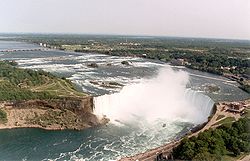
Knickpoint
Encyclopedia

Geomorphology
Geomorphology is the scientific study of landforms and the processes that shape them...
to describe a location in a river
River
A river is a natural watercourse, usually freshwater, flowing towards an ocean, a lake, a sea, or another river. In a few cases, a river simply flows into the ground or dries up completely before reaching another body of water. Small rivers may also be called by several other names, including...
or channel
Channel (geography)
In physical geography, a channel is the physical confine of a river, slough or ocean strait consisting of a bed and banks.A channel is also the natural or human-made deeper course through a reef, sand bar, bay, or any shallow body of water...
where there is a sharp change in channel slope
Slope
In mathematics, the slope or gradient of a line describes its steepness, incline, or grade. A higher slope value indicates a steeper incline....
, such as a waterfall
Waterfall
A waterfall is a place where flowing water rapidly drops in elevation as it flows over a steep region or a cliff.-Formation:Waterfalls are commonly formed when a river is young. At these times the channel is often narrow and deep. When the river courses over resistant bedrock, erosion happens...
or lake
Lake
A lake is a body of relatively still fresh or salt water of considerable size, localized in a basin, that is surrounded by land. Lakes are inland and not part of the ocean and therefore are distinct from lagoons, and are larger and deeper than ponds. Lakes can be contrasted with rivers or streams,...
, resulting from differential rates of erosion
Erosion
Erosion is when materials are removed from the surface and changed into something else. It only works by hydraulic actions and transport of solids in the natural environment, and leads to the deposition of these materials elsewhere...
above and below the knickpoint. Differential rates of erosion can result from a change in the lithology
Lithology
The lithology of a rock unit is a description of its physical characteristics visible at outcrop, in hand or core samples or with low magnification microscopy, such as colour, texture, grain size, or composition. It may be either a detailed description of these characteristics or be a summary of...
of the river channel. Sharp changes in channel slope caused by faulting
Geologic fault
In geology, a fault is a planar fracture or discontinuity in a volume of rock, across which there has been significant displacement along the fractures as a result of earth movement. Large faults within the Earth's crust result from the action of tectonic forces...
or in-channel construction are not considered knickpoints.
Knickpoints can also be caused by a change in base level
Base level
The base level of a river or stream is the lowest point to which it can flow, often referred to as the 'mouth' of the river. For large rivers, sea level is usually the base level, but a large river or lake is likewise the base level for tributary streams...
. When a river is rejuvenated
Rejuvenation (river)
A river is said to be rejuvenated when the base level that it is flowing down to is lowered. This can happen for various reasons.-Signs:Rejuvenated terrains usually have complex landscapes because remnants of older landforms are locally preserved. Parts of floodplains may be preserved as terraces...
(that is, has a negative change in base level, the sea level falls), the long profile is lengthened as land rises from the sea. This increases the gradient
Gradient
In vector calculus, the gradient of a scalar field is a vector field that points in the direction of the greatest rate of increase of the scalar field, and whose magnitude is the greatest rate of change....
of the long profile and causes the river to gain more erosive energy. The first knickpoint marks the position of the former base level but the knick point moves towards the source of the river as under rock erodes away to create a graded profile.
The river, having gained more potential energy due to gravity, will then proceed to work the knickpoints out of its system by either erosion (in the case of waterfalls) or deposition (in the case of lakes) in order for the river to reattain its smooth concave graded profile.
As is observed for many major waterfalls, knickpoints migrate upstream due to bedrock erosion.

